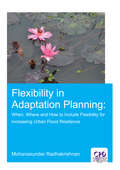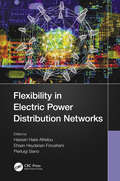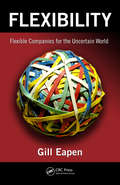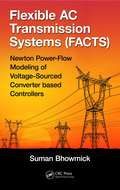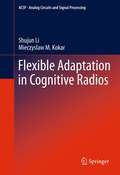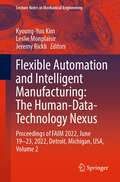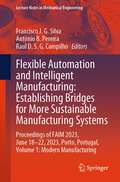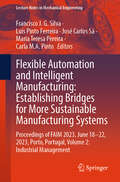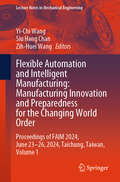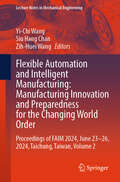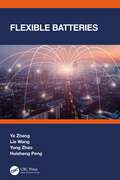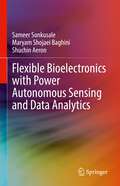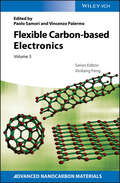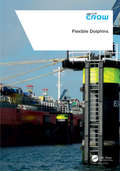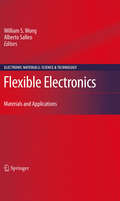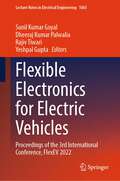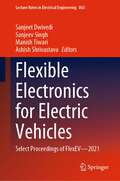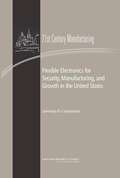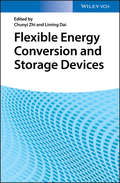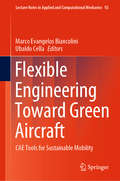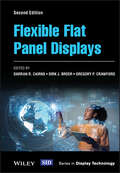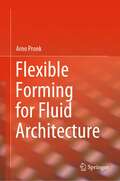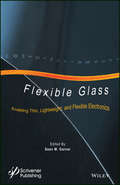- Table View
- List View
Flexibility in Adaptation Planning: When, Where and How to Include Flexibility for Increasing Urban Flood Resilience (IHE Delft PhD Thesis Series)
by Mohanasundar RadhakrishnanThe magnitude and urgency of the need to adapt to climate change is such that addressing it has been taken up by the United Nations as one of the sustainable development goals - Goal 13 (SDG13) in 2015. SDG13 emphasises the need to strengthen resilience and adaptive capacity to climate related hazards and natural disasters. Coping with urban floods is one of the major needs of climate adaptation, where integration of climate change responses into flood risk management policies, strategies and planning at international, national, regional and local levels is now the norm. However, much of this integration lacks effectiveness or real commitment from stakeholders involved in adaptation planning and implementation. Hence this research has focused on integrating flexibility based adaptation responses into an urban flood risk management context. The research has synthesised flexible adaptation practices from several disciplines including information technology, automobile and aerospace manufacturing. The outcomes of the research are brought together in a framework for structuring local adaptation responses and an adaptation planning process based on flexibility concepts. The outcomes provide a way to assist with the identification of the appropriate nature and type of flexibility required; where flexibility can best be incorporated; and when is the most appropriate time to implement the flexible adaptation responses in the context of urban flooding.
Flexibility in Electric Power Distribution Networks
by Hassan Haes Alhelou Pierluigi Siano Ehsan Heydarian-ForushaniHigh penetration of renewable energy sources (RESs) imposes several techno-economic challenges to distribution system operators (DSOs) due to their variability in power generation and hence, increases the need for additional operational flexibility. Operational flexibility aims at securely covering the possible variations at least cost using emerging flexible alternatives or designing novel local market mechanisms to incentivize flexibility providers. In such a situation, the DSOs can use the potential of flexible options such as Energy Storages (ESs), Demand Response (DR), Plug-in Electric Vehicles (PEVs) or on-site fast run generators. However, each of the mentioned flexible resources has its own specific characteristics and requirements that should be taken into account and this raises the problem complexity. Optimal network reconfiguration schemes are also the other solution for increasing power system flexibility at distribution level. There is a great research gap related to renewable-based distribution network planning with flexibility point of view. Therefore, this book aims to discuss the additional flexibility needs introduced by RESs and describe general approaches to analyze the need for and provision of additional flexibility in future distribution networks at both planning and operational time frames. This book successfully suggests new solutions and techniques to increase the flexibility in distribution systems. This book also highlights the needs for moving towards smart distribution grids in order to enhance the flexibility in modern and future power systems.
Flexibility: Flexible Companies for the Uncertain World
by Gill EapenWe are in an era of high volatility and uncertain outcomes, driven by accelerating technologies, shortened product cycles, fast-changing information, an increasingly mobile workforce, more demanding customers, complex financial markets, ad-hoc public policies, and many other factors that add layers of uncertainty to all future possibilities. In an information- and knowledge-driven environment with high levels of uncertainty, most traditional ideas of structure, system, and strategy are ineffective. This book shows how to create, maintain, and accelerate an organization in a highly uncertain environment using flexibility. It analyzes the organization holistically and details its primary components independently. The author presents an economic framework of decision options to diagnose existing flexibility problems and provides guidance on how to improve flexibility and reduce risk. The text also describes how to design and maintain a high performance organization for the long run in an environment of high uncertainty.
Flexible AC Transmission Systems (FACTS): Newton Power-Flow Modeling of Voltage-Sourced Converter-Based Controllers
by Suman BhowmickFlexible AC Transmission Systems (FACTS): Newton Power-Flow Modeling of Voltage-Sourced Converter-Based Controllers introduces different voltage-sourced converter (VSC)-based FACTS controllers and VSC-based high-voltage direct current (VSC-HVDC) systems and their working principles, explaining how FACTS controllers exchange real and reactive power with systems. Subsequently, the book: Describes the Newton–Raphson method and its application for solving the power-flow problem Presents the Newton power-flow modeling of the static synchronous series compensator (SSSC), unified power-flow controller (UPFC), interline power-flow controller (IPFC), generalized unified power-flow controller (GUPFC), and static synchronous compensator (STATCOM), accommodating the practical device constraint limits (because of the unique modeling strategy, the existing Newton power-flow codes can be reused) Develops a unified Newton power-flow model of AC systems incorporating multiterminal VSC-HVDC systems with pulse-width modulation (PWM) control schemes, directly yielding the VSC modulation indices from the power-flow solution Provides numerous case studies for validation of Newton power-flow models, elaborating on the occurrences and checking of unrealistic power-flow solutions in isolated cases Includes detailed derivations of all the difficult formulae as well as solved problems on typical VSC-based FACTS controllers Flexible AC Transmission Systems (FACTS): Newton Power-Flow Modeling of Voltage-Sourced Converter-Based Controllers assumes at least an undergraduate-level understanding of engineering mathematics, network analysis, electrical machines, electrical power systems, and power electronics. Thus, the book provides a valuable reference for practitioners as well as senior-undergraduate and graduate students in electrical engineering and electrical power systems.
Flexible Adaptation in Cognitive Radios
by Miecyslaw Kokar Shujun LiThis book provides an introduction to software-defined radio and cognitive radio, along with methodologies for applying knowledge representation, semantic web, logic reasoning and artificial intelligence to cognitive radio, enabling autonomous adaptation and flexible signaling. Readers from the wireless communications and software-defined radio communities will use this book as a reference to extend software-defined radio to cognitive radio, using the semantic technology described.
Flexible Automation and Intelligent Manufacturing: Proceedings of FAIM 2022, June 19–23, 2022, Detroit, Michigan, USA (Lecture Notes in Mechanical Engineering)
by Kyoung-Yun Kim Leslie Monplaisir Jeremy RickliThis is an open access book. It gathers the first volume of the proceedings of the 31st edition of the International Conference on Flexible Automation and Intelligent Manufacturing, FAIM 2022, held on June 19 – 23, 2022, in Detroit, Michigan, USA. Covering four thematic areas including Manufacturing Processes, Machine Tools, Manufacturing Systems, and Enabling Technologies, it reports on advanced manufacturing processes, and innovative materials for 3D printing, applications of machine learning, artificial intelligence and mixed reality in various production sectors, as well as important issues in human-robot collaboration, including methods for improving safety. Contributions also cover strategies to improve quality control, supply chain management and training in the manufacturing industry, and methods supporting circular supply chain and sustainable manufacturing. All in all, this book provides academicians, engineers and professionals with extensive information on both scientific and industrial advances in the converging fields of manufacturing, production, and automation.
Flexible Automation and Intelligent Manufacturing: Proceedings of FAIM 2022, June 19–23, 2022, Detroit, Michigan, USA, Volume 2 (Lecture Notes in Mechanical Engineering)
by Kyoung-Yun Kim Leslie Monplaisir Jeremy RickliThis book gathers the second volume of the proceedings of the 31st edition of the International Conference on Flexible Automation and Intelligent Manufacturing, FAIM 2022, held on June 19 – 23, 2022, in Detroit, Michigan, USA. Covering four thematic areas including Manufacturing Processes, Machine Tools, Manufacturing Systems, and Enabling Technologies, it highlights advances in micro- and nanoscales processes, additive manufacturing, artificial intelligence and robotic applications, human-robot collaboration, as well as quality control, supply chain, industrial monitoring and management strategies. It also discusses important issues related to sustainability, waste management and remanufacturing. All in all, this book provides academicians, engineers and professionals with extensive information on both scientific and industrial advances in the converging fields of manufacturing, production, and automation.
Flexible Automation and Intelligent Manufacturing: Proceedings of FAIM 2023, June 18–22, 2023, Porto, Portugal, Volume 1: Modern Manufacturing (Lecture Notes in Mechanical Engineering)
by Francisco J. G. Silva António B. Pereira Raul D. S. G. CampilhoThis book reports on cutting-edge research and developments in manufacturing, giving a special emphasis to solutions fostering automation and sustainability. Topics cover manufacturing process optimization, remanufacturing, machines and mechanical design, CAD/CAM/CAE, materials characterization and processing, measurement and predictive maintenance techniques. Further topics include artificial intelligence and IoT in manufacturing, robotics, and cutting-edge issues in Industry 4.0/5.0. Based on proceedings of the 32nd edition of the International Conference on Flexible Automation and Intelligent Manufacturing, FAIM 2023, held on June 18 – 22, 2023, in Porto, Portugal, this first volume of a 2-volume set provides academics and professionals with extensive, technical information on trends and technologies in manufacturing, yet it also discusses challenges and practice-oriented experience in all the above-mentioned areas.
Flexible Automation and Intelligent Manufacturing: Proceedings of FAIM 2023, June 18–22, 2023, Porto, Portugal, Volume 2: Industrial Management (Lecture Notes in Mechanical Engineering)
by Carla M. A. Pinto José Carlos Sá Francisco J. G. Silva Luís Pinto Ferreira Maria Teresa PereiraThis book reports on cutting-edge research and developments in manufacturing, giving a special emphasis to solutions fostering automation, sustainability and health, safety and well-being at work. Topics cover manufacturing process analysis and optimization, supply chain management, quality control, as well as human factors and logistics. They highlight the role and advantages of intelligent systems and technologies, discussing current best-practices and challenges to cope with in the near future. Based on proceedings of the 32nd edition of the International Conference on Flexible Automation and Intelligent Manufacturing, FAIM 2023, held on June 18–22, 2023, in Porto, Portugal, this second volume of a 2-volume set provides academics and professionals with extensive information on innovative strategies for industrial management in the era of industry 5.0.
Flexible Automation and Intelligent Manufacturing: Proceedings of FAIM 2024, June 23–26, 2024, Taichung, Taiwan, Volume 1 (Lecture Notes in Mechanical Engineering)
by Yi-Chi Wang Siu Hang Chan Zih-Huei WangThis book reports on cutting-edge research and developments in manufacturing, giving a special emphasis to solutions for the Changing World Order. It covers applications of machine learning in manufacturing and advances in cyber-physical systems, human-robot collaboration, and machine tools and assembly systems. It also reports on advances in logistics and supply chain, and lean manufacturing. Based on the proceedings of the 33rd International Conference on Flexible Automation and Intelligent Manufacturing (FAIM2024), held on June 23-26, 2024, in Taichung, Taiwan, this first volume of a 2-volume set provides academics and professionals with extensive, technical information on trends and technologies in manufacturing, yet it also discusses challenges and practice-oriented experience in all the above-mentioned areas.
Flexible Automation and Intelligent Manufacturing: Proceedings of FAIM 2024, June 23–26, 2024, Taichung, Taiwan, Volume 2 (Lecture Notes in Mechanical Engineering)
by Yi-Chi Wang Siu Hang Chan Zih-Huei WangThis book reports on cutting-edge research and developments in manufacturing, giving a special emphasis to solutions for the Changing World Order. It covers advances in manufacturing processes and systems, applications of AI and machine learning in manufacturing, sustainable manufacturing strategies, quality management in industry 4.0, and topics in ergonomics, engineering education and project management. Based on the proceedings of the 33rd International Conference on Flexible Automation and Intelligent Manufacturing (FAIM2024), held on June 23-26, 2024, in Taichung, Taiwan, this second volume of a 2-volume set provides academics and professionals with extensive, technical information on trends and technologies in manufacturing, yet it also discusses challenges and practice-oriented experience in all the above-mentioned areas.
Flexible Batteries
by Yang Zhao Huisheng Peng Ye Zhang Lie WangFlexible Batteries highlights the key advances in flexible batteries, a booming new direction in the energy storage field. The authors first introduce lithium-ion batteries, which are currently the most widely used batteries. Flexible aqueous batteries such as aqueous lithium-ion, sodium-ion, and zinc-ion batteries are discussed subsequently due to the safety concerns in organic electrolytes. Since flexible metal-air batteries are recognized as primary choices for the next generation, the authors take lithium-air and aluminum-air batteries as examples to explore their applications in flexible battery construction. They further summarize flexible batteries under the most challenging working conditions such as stretching and integrating flexible batteries with flexible energy harvesting devices, sensors, and supercapacitors. Covering both fundamental and application development, this book may effectively bridge academics and industry. It will be helpful not only to scholars and students studying materials science and engineering, chemical engineering, physics, energy science, and biomedical science but also to scientists and engineers in the industry.
Flexible Bioelectronics with Power Autonomous Sensing and Data Analytics
by Sameer Sonkusale Maryam Shojaei Baghini Shuchin AeronThis book provides readers with an introduction to the materials and devices necessary for flexible sensors and electronics, followed by common techniques for fabrication of such devices and system-level integration. Key insights into fabrication and processing will guide readers through the tradeoff choices in designing such platforms. A comprehensive review of two specific, flexible bioelectronic platforms, related to smart bandages for wound monitoring and thread-based diagnostics for wearable health, will demonstrate practical application at the system level. The book also provides a unique electrical engineering perspective by reviewing circuit architectures for low noise signal conditioning of weak signals from sensors,, and for low power analog to digital converters for signal acquisition. To achieve energy autonomy, authors provide several example of CMOS energy harvesting front end circuits and voltage boosters. Beyond circuit architectures, the book also provides a review of the modern theory of sampling and recovery of sparse signals, also known as compressed sensing. They then highlight how these principles can be leveraged for design and implementation of efficient signal acquisition hardware and reliable processing of acquired data for flexible electronic platforms.
Flexible Carbon-based Electronics (Advanced Nanocarbon Materials)
by Xinliang Feng Paolo Samorí Vincenzo PalermoThis third volume in the Advanced Nanocarbon Materials series covers the topic of flexible electronics both from a materials and an applications perspective. Comprehensive in its scope, the monograph examines organic, inorganic and composite materials with a section devoted to carbon-based materials with a special focus on the generation and properties of 2D materials. It also presents carbon modifications and derivatives, such as carbon nanotubes, graphene oxide and diamonds. In terms of the topical applications covered these include, but are not limited to, flexible displays, organic electronics, transistors, integrated circuits, semiconductors and solar cells. These offer perspectives for today?s energy and healthcare challenges, such as electrochemical energy storage and wearable devices. Finally, a section on fundamental properties and characterization approaches of flexible electronics rounds off the book. Each contribution points out the importance of the structure-function relationship for the target-oriented fabrication of electronic devices, enabling the design of complex components.
Flexible Dolphins
by CrowMillions of breasting and mooring dolphins have been installed in inland waterways adjacent to jetties and waiting facilities for ship-to-ship transhipment or as crash barriers in commercial port areas throughout the world. A dolphin is a marine structure that is frequently installed in ports, waterways and other places related to marine traffic. Dolphins are typically located adjacent to waterfront structures such as quay walls, jetties, locks and bridge piers. The purpose of a dolphin is threefold: Allow ships to berth and moor safely and efficiently Protect waterfront structures by acting as a crash barrier and sacrificial structure Direct and guide marine traffic by acting as a lead-in dolphin and navigation aid The main objective of this handbook is to provide engineers, asset managers, suppliers, tender teams, contractors and principals with such guidance on the design and construction of flexible dolphins by collecting and describing knowledge of and experience with these flexible marine structures.This handbook is intended to prevent extensive discussions during the design and construction stages of projects involving flexible dolphins. It is part of a series of Dutch port infrastructure design recommendations that include the Quay Walls handbook and Jetties and Wharfs handbook.
Flexible Electronic Packaging and Encapsulation Technology
by Hong MengFlexible Electronic Packaging and Encapsulation Technology A systematic introduction to the future of electronic packaging Electronic packaging materials are among the most important components of the broader electronics industry, capable of facilitating heat dissipation, redistributing stress on electronic components, and providing environmental protections for electronic systems. Recent advances in integrated circuits, especially the development of flexible electronic technology, have placed increasingly stringent demands on the capabilities of electronic packaging. These technologies have the potential to reshape our world, and they demand a generation of engineers capable of harnessing that potential. Flexible Electronic Packaging and Encapsulation Technology meets this demand with an introduction to the cutting-edge technologies available to package electronic components, as well as the testing methods and applications that bring these technologies to bear on the industry. These packaging technologies promise to bring lightness, flexibility, and environmental friendliness to the next generation of electronic systems. Flexible Electronic Packaging and Encapsulation Technology readers will also find: Survey of commercial electronic packaging materials and patents for reference purposesGuidelines for designing high-performance packaging materials with novel structuresAn authorial team of leading researchers in the field Flexible Electronic Packaging and Encapsulation Technology is ideal for materials scientists, electronics engineers, solid state physicists, professionals in the semiconductor industry, and any other researchers or professionals working with electronic systems.
Flexible Electronics
by Alberto Salleo William S. WongThis excellent volume covers a range of materials used for flexible electronics, including semiconductors, dielectrics, and metals. The functional integration of these different materials is treated as well. Fundamental issues for both organic and inorganic materials systems are included. A corresponding overview of technological applications, based on each materials system, is presented to give both the non-specialist and the researcher in the field relevant information on the status of the flexible electronics area.
Flexible Electronics for Electric Vehicles: Proceedings of the 3rd International Conference, FlexEV 2022 (Lecture Notes in Electrical Engineering #1065)
by Rajiv Tiwari Sunil Kumar Goyal Dheeraj Kumar Palwalia Yeshpal GuptaThis volume comprises the select proceedings of the 3rd Conference on Flexible Electronics for Electric Vehicles (FlexEV 2022). It aims to provide a comprehensive and broad-spectrum picture of the state-of-the-art research and development in flexible electronics & applications, electric vehicle technology & infrastructures, materials & devices, battery management & intelligent systems. This volume will prove a valuable resource for those in academia and industry.
Flexible Electronics for Electric Vehicles: Select Proceedings of FlexEV—2021 (Lecture Notes in Electrical Engineering #863)
by Manish Tiwari Sanjeev Singh Ashish Shrivastava Sanjeet DwivediThis book compiles the refereed papers presented during the 2nd Flexible Electronics for Electric Vehicles (FlexEV - 2021). It presents the diligent work of the research community on flexible electronics applications in different allied fields of engineering - engineering materials to electrical engineering to electronics and communication engineering. The theoretical research concepts are supported with extensive reviews highlighting the trends in the possible and real-life applications of electric vehicles. This book will be useful for research scholars, electric vehicles professionals, driving system designers, and postgraduates from allied domains. This book incorporates economical and efficient electric vehicle driving and the latest innovations in electric vehicle technology with their paradigms and methods that employ knowledge in the research community.
Flexible Electronics for Security, Manufacturing, and Growth in the United States
by National Research Council Policy and Global Affairs Board on Science, Technology, and Economic Policy Sujai J. Shivakumar Committee on Best Practice in National Innovation Programs for Flexible ElectronicsFlexible Electronics for Security, Manufacturing, and Growth in the United States is the summary of a workshop convened in September 2010 by Policy and Global Affairs' Board on Science, Technology, and Economic Policy to review challenges, plans, and opportunities for growing a robust flexible electronics industry in the United States. Business leaders, academic experts, and senior government officials met to review the role of research consortia around the world to advance flexible electronics technology. Presenters and participants sought to understand their structure, focus, funding, and likely impact, and to determine what appropriate steps the United States might consider to develop a robust flexible electronics industry. Flexible electronics refers to technologies that enable flexibility in the manufacturing process as well as flexibility as a characteristic of the final product. Features such as unconventional forms and ease of manufacturability provide important advantages for flexible electronics over conventional electronics built on rigid substrates. Today, examples of flexible electronics technologies are found in flexible flat-panel displays, medical image sensors, photovoltaic sheets, and electronic paper. Some industry experts predict that the market for global flexible electronics will experience a double digit growth rate, reaching $250 billion by 2025, but most experts believe that the United States is not currently poised to capitalize on this opportunity. Flexible Electronics for Security, Manufacturing, and Growth in the United States examines and compares selected innovation programs, both foreign and domestic, and their potential to advance the production of flexible electronics technology.
Flexible Energy Conversion and Storage Devices
by Liming Dai Chunyi ZhiReviewing recent progress in flexible energy conversion and storage devices, this highly relevant book introduces not only the basic principles and strategies to make a device flexible, but also the applicable materials and technologies. Adopting an application-oriented approach throughout, the text discusses perspectives for different devices, such as batteries, supercapacitors, solar cells and fuel cells, covering such technologies as polymers, carbon materials, nanotechnologies and textile technologies.
Flexible Engineering Toward Green Aircraft: CAE Tools for Sustainable Mobility (Lecture Notes in Applied and Computational Mechanics #92)
by Marco Evangelos Biancolini Ubaldo CellaThis book discusses the recent advances in aircraft design methodologies. It provides an overview of topics such as shape optimization, robust design and aeroelasticity, focusing on fluid-structure numerical methodologies to address static and dynamic aeroelastic problems. It demonstrates that the capability to evaluate the interaction between aerodynamics, inertia and elastic forces is important to avoid drag penalties, control system efficiency loss and generation of potentially dangerous phenomena, such as divergence, control reversal and flutter. The book particularly highlights the advances in “high fidelity” CFD-CSM coupling, describing the latest experimental research to validate the numerical fluid-structure interaction analysis methodologies resulting from the EU-funded RBF4AERO and RIBES projects.
Flexible Flat Panel Displays (Wiley Series in Display Technology)
by Dirk J. Broer Gregory P. Crawford Darran R. CairnsFlexible Flat Panel Displays A complete treatment of the entire lifecycle of flexible flat panel displays, from raw material selection to commercialization In the newly revised Second Edition of Flexible Flat Panel Displays, a distinguished team of researchers delivers a completely restructured and comprehensive treatment of the field of flexible flat panel displays. With material covering the end-to-end process that includes commercial and technical aspects of the technology, the editors have included contributions that introduce the business, marketing, entrepreneurship, and intellectual property content relevant to flexible flat panel displays. This edited volume contains a brand-new section on case studies using the Harvard Business School format that discusses current and emerging markets in flexible displays, such as an examination of the use of electronic ink and QD Vision in commercial devices. From raw material selection to device prototyping, manufacturing, and commercialization, each stage of the flexible display business is discussed in this insightful new edition. The book also includes: Thorough introductions to engineered films for display technology and liquid crystal optical coatings for flexible displays Comprehensive explorations of organic TFT foils, metallic nanowires, adhesives, and self-healing polymer substrates Practical discussions of flexible glass, AMOLEDs, cholesteric displays, and electronic paper In-depth examinations of the encapsulation of flexible displays, flexible batteries, flexible flat panel photodetectors, and flexible touch screens Perfect for professionals working in the field of display technology with backgrounds in science and engineering, Flexible Flat Panel Displays is also an indispensable resource for professionals with marketing, sales, and technology backgrounds, as well as senior undergraduates and graduate students in engineering and materials science.
Flexible Forming for Fluid Architecture
by Arno PronkThis book on flexible formwork for fluid architecture is a multi-faceted research that covers a broad field: from design to material and technology, and from history to future developments. It offers a pragmatic approach that can be extended with more cases, materials, techniques and methods for fluid architecture, and provides a better understanding of the main aspects of fluid architecture and to help them find the most suitable combinations of all aspects.The book is a challenging experience with many new discoveries, including two patents: one on moulding of fluid surfaces and one on 3D printing of fibre–reinforced ice. It also features two world records: the larges span (30 meters) and the highest thin shell structure (30,5 meters) in ice as well as a method for the construction of a fully laminated shell structure in insulated glass.
Flexible Glass: Enabling Thin, Lightweight, and Flexible Electronics
by Sean M GarnerThis book details flexible glass properties that enable use in emerging electronic and opto-electronic applications. Discussion includes flexible glass advantages compared to alternative substrate materials. Examples describe flexible glass in processes such as vacuum deposition, monolithic integration, printing, and roll-to-roll. Flexible glass demonstrations in emerging applications such as photovoltaics, flexible displays, and optical interconnects are also detailed. The reader will find in this unique book: Discussion of flexible glass processing and mechanical reliability. Demonstration of flexible glass in roll-to-roll (R2R) fabrication processes. Flexible glass substrate examples in displays, sensors, and photovoltaics. Flexible glass ecosystem description for identification of new applications.
